|
|
The Tetrarch

|
|
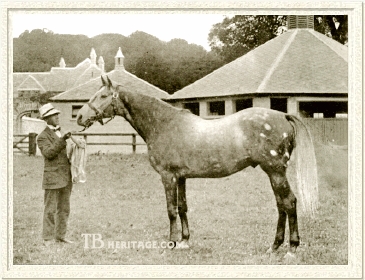 |
|
|
The Tetrarch, "the Spotted Wonder," only raced as a two-year-old, but the impression he left was of unlimited speed and untested talent. At stud, the big, flashy grey proved a successful stallion, although his infertility once again left horsemen wondering what could have been. Despite this, The Tetrarch's influence of brilliant speed helped create an international dynasty of stallions, keeping his name alive through the generations.
There was a brief moment in the saddling paddock at Newmarket on April 17, 1913 when racegoers made a joke of the gangly grey colt who was speckled black and white like a child's rocking horse. The laughter dissolved into awe when The Tetrarch, Steve Donoghue up, who went off at 5-1 odds (third choice in the betting), exploded away from his 22 rivals to win his debut, a maiden two-year-old plate, by four lengths "in a canter." The crowd knew they had seen something out of the ordinary; they just didn't know how exceptional he would prove to be.
On June 3, at Epsom, The Tetrarch turned out for the Woodcote Stakes, and had the race in hand after the first quarter mile of the six furlong test. He and Donoghue, who rode him in all his races, won easily by three lengths, and, according to the British Bloodstock Review "It was generally agreed that not since the days of Pretty Polly had a two-year-old accomplished a more impressive performance."
Shipped to the Royal Ascot meeting for the five furlong Coventry Stakes on June 17, The Tetrarch went off at 100 to 30. He won with consummate ease, with Courageous, the closest of seven competitors, trailing in behind by ten lengths, run off his feet.
On July 19 at Sandown, The Tetrarch appeared for the National Breeders' Produce Stakes, also at five furlongs. Eight runners opposed him, and The Tetrarch gave his supporters their first real scare, getting off very badly in what was a poor start for all. He quickly caught up with the pack and took control after a quarter of a mile, but the effort might have softened him for the strong move from the filly Calandria, who dueled with him down the stretch and finished within a neck of him at the wire. Onlookers contend that The Tetrarch was never in danger, and that Donoghue wisely chose to keep the colt steady after the start, and merely held off the filly as needed to win.
Reports are unclear about the nature of this bad start, and one source says The Tetrarch "had an 'argument' with the tapes just before the barrier was raised and, taken unawares, lost many lengths before he began to race." Another says he was "facing the wrong way when the field was sent away." The BBR that year simply notes "The start was a rather straggling affair, and the favourite was one of the chief sufferers, for he lost four or five lengths." Whatever the case, a myth arose that The Tetrarch had gotten tangled in the tapes at the start, but this is unsubstantiated.
Moving on to the Goodwood meeting, on July 31, The Tetrarch reclaimed his reputation by trouncing a field of five in the six furlong Rous Memorial, beating the next season's Oaks winner Princess Dorrie, in second place. Moving on to Derby, The Tetrarch's appearance in the Champion Breeders' Foal Stakes on September 2 scared off the other good two-year-old of the season, Stornoway, and the grey colt won as he pleased by four lengths.
On September 9, Stornoway's connections could no longer hide, and he faced The Tetrarch for the first time in the September 9 Champagne Stakes at Doncaster. The race was virtually a match, since only one other runner dared to challenge, the filly Eulogy. The Tetrarch vindicated himself fully against Stornoway, having the race in hand early and winning by three lengths.
The Tetrarch was being pointed for the Imperial Produce Stakes run in October at Kempton, but injured himself in a slow gallop the morning before, striking the off fore with a hind leg, something he was prone to do as a result of an unusually long overstride. Pulling up lame, the Roi Herode colt was put away for the season and the injury allowed to heal. In the meantime, the racing world sat back and tried to digest what they had just witnessed, probably the greatest two-year-old of all time, and possibly the greatest runner ever.
One immediate result of The Tetrarch's juvenile campaign was the oversubscription of his sire, Roi Herode, not just for the rest of the 1913 breeding season, but for the next two years, through 1915. Roi Herode stood at Straffan Stud in Ireland where The Tetrarch had been foaled, one of just a few foals from his sire's first small crop.
|
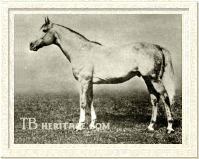
Roi Herode
| |
Roi Herode
Roi Herode was bred in France in 1904 by Maurice Caillaut and the Comte de Pourtales. He was a grey son of the grey Le Samaritain (1895), a very good stakes winner in France (winner of the Grand Prix de Deauville, Grand St. Leger de France, Prix Daru), and himself a son of the grey Le Sancy. Le Sancy was the dominant sire in France in his time, although his male line back through Atlantic, Thormanby, Windhound, and Pantaloon, was one of the last surviving remnants of the once mighty Herod male line (Pantaloon was by Castrel, by Buzzard, by Woodpecker, by Herod).
|
Roi Herode, out of the mare Roxelane, by War Dance (the French War Dance, by Galliard - War Paint, not to be confused with the American one, by Lexington - Reel). This gave Roi Herode an interesting pedigree background, because not only was he inbred 4x4 to his tail-male ancestor Thormanby, but his second dam, Rose of York, was a half-sister to the great Derby winner and sire Bend Or, both out of Thormanby's daughter Rouge Rose. Roxelane had been an outstanding racemare in her own right, winner of the Poule d'Essai des Pouliches (French 1,000 Guineas) and Prix de Diane (French Oaks), and she was a full sister to the Poule d'Essai des Poulains (French 2,000 Guineas) winner Rodilard.
Roi Herode was unplaced in both of his starts at two. At three, he ran 13 times, but could win only once, in the Prix de la Neva, run at Paris in June, a 3,000 meters event (about 1 mile, 7 furlongs). He ran second four times, in the Prix La Rochette (in his season debut, at 2,200 meters), Prix de Rocquencourt (2,400 meters), Prix du President de la Republique (2,500 meters), and Prix Royal Oak (French St. Leger, 3,000 meters). At four, Roi Herode got a late start on the season and made only three starts, although he won his debut in the Grand Prix de la Ville de Vichy, and was second in the Prix de Madrid. Returning at five, the son of Le Samaritain ran six times, including a win in the Prix de la Table (3,000 meters), second in the Doncaster Cup (2 miles, 1 furlong), and third in the Prix Hocquart (3,000 meters).
His performance in the Doncaster Cup caught the eye of Irish breeder Edward Kennedy, whose homebred Dark Ronald had come in third behind Amadis and Roi Herode. Impressed, and enamoured of his rare Herod male line, Kennedy purchased Roi Herode from Monsieur Caillaut for 2,000 guineas. He sent the big grey to trainer, Atty Persse, who was stabled at Stockbridge, in Hampshire, and set his sights on the Chester Cup the next year. Roi Herode trained well into the spring, but bowed a tendon shortly before the target race, forcing his retirement to Kennedy's Straffan Stud, near Baronrath, Bishopscourt, County Kildare, Ireland.
Kennedy had made his fortune selling cattle, and was a long-time lover of race horses, so it was only a matter of time before he started an Irish stud of his own for both ventures. He first owned Newtown Stud (near Hazlehatch), then expanded to a larger farm near Baronrath, and renamed the joint operation Straffan Station Stud. He had already bred the good runners Delaunay (by Fortunio - Pet by Peter) and Dark Ronald (by Bay Ronald - Darkie by Thurio). He initially stood Fortunio and Westmoreland, then Symington, before adding Roi Herode to the stud.
Although the 1910 breeding season was well underway, Kennedy managed to get 12 mares bred, including his own mare Vahren. The next spring Vahren produced The Tetrarch, who, two years later, catapulted Roi Herode to the news as a hot, young sire.
His race record suggested Roi Herode was an adequate stayer, best at around 3,000 meters, and his physical type was an extreme, very large, stoutly built, more like a coach horse. Ulbrich also notes that he had low heels and flat feet which he tended to pass on. Despite this, he proved to be a very successful sire, and besides The Tetrarch, he got more than a few classy runners and influential sires and dams. Trainer Persse insisted that Roi Herode had more brilliant speed than the record attributes to him, and perhaps that's the reason for his success at stud.
After The Tetrarch, most of Roi Herode's best runners began to appear out of the foal crops conceived following The Tetrarch's two-year-old season, in 1913. His 1915 crop included Irish Derby winner King John, and Iris Oaks winner Judea. He also sired the Irish Oaks winner Cinq A Sept (foaled 1924), Irish 2,000 Guineas winner St Donagh (1922), and the good two-year-old Milesius (1918), winner of the Coventry Stakes at Royal Ascot.
Besides The Tetrarch, who was by far his best son at stud, Roi Herode's good sire sons included Royal Canopy (who was unraced, but sired Irish Oaks winner Miss Hazelwood), Sir Greysteel (sire of American champions Tred Avon, Lady Maryland), Herodote (sire of Irish 1,000 Guineas winner Moucheron), Roidore, Chrysolaus, and Milesius (sired Azucar).
Roi Herode's daughters were generally better by comparison, and many proved especially influential when imported into America. Cinq a Sept became the tail-female ancestress of both Secretariat and Alleged. Lady Comfey became the dam of Man o'War's first champion son, American Flag. La Grisette produced La Chica, from which descends the great Native Dancer, and the important broodmare Grey Flight. Regal Roman was the dam of the champion filly Alcibiades, later dam of Menow, Salaminia, and fourth dam of Sir Ivor.
In Europe, Roi Herode's classic winning daughter Judea produced Irish Derby winner Zionist. May Queen was the dam of Prix du Jockey Club winner Strip the Willow. Dora Agnes produced Prix de Diane winner Dorina. Tabaris was the dam of Irish 1,000 Guineas winner Kyloe, and the sire Admiral's Walk.
Roi Herode died June 8, 1931 and was buried at Straffan Stud, alongside Vahren, dam of his greatest offspring, The Tetrarch.
|

Vahren
| |
Vahren The Tetrarch's dam, Vahren, was foaled in 1897, a daughter of Bona Vista out of Castania by Hagioscope.
Her sire, Bona Vista, was bred on the popular Bend Or/Macaroni nick. He had won the 2,000 Guineas, and had made a few seasons at stud in England before being sold to Hungary the year Vahren was born. So when his son Cyllene (1895) came on the scene racing at two in 1897, Bona Vista was missed, but lived out his days as one of the best sires on the continent, and the leading sire in Hungary for 1902-1905, and 1908. Cyllene was by far his most important product, later winner of the Ascot Gold Cup and a leading sire in England and Argentina. |
Vahren's dam, the unraced Castania, produced 12 foals, but only four winners, none of which were very important. Her dam Rose Garden was also unraced, and had one winner from six foals. The next dam, Eglentyne was the first mare of any class in the female line, being the dam of seven winners, in particular Briar Root, winner of the 1,000 Guineas in 1888. The next dam, Mabille, was a full sister to 1872 Derby winner Cremorne.
As a runner, Vahren had won three races, from nine to eleven furlongs. In her first breeding season, she was bred to St. Frusquin but slipped, and in this condition, was purchased privately by Edward Kennedy at the 1904 Newmarket sales for £200 from her owner Oscar Rayner, after the mare had gone through the ring without attracting a single bid. Bred to Kennedy's own Fortunio, she produced dead twins in 1905 and again in 1906. In 1907, she was bred to Symington, but did not conceive. Things were looking grim.
Vahren didn't produce her first foal until 1908, when she delivered the Symington filly Nicola, but once in step, got in foal regularly thereafter, until her death after delivering a filly by Prince Philip in 1921. Nicola proved a good two-year-old and sprinter and further rewarded Kennedy by producing the precocious colt Milesius, by Roi Herode in 1918. Vahren's 1909 foal was a filly by John O'Gaunt named Coup d'Or, who was sold as a yearling for 650 guineas and sent to Russia, where she won the Russian Oaks. Unfortunately, Vahren left little else of distinction besides The Tetrarch himself.
Vahren was a chestnut mare with white on both hind legs, and a large star and stripe on her faces. Bred in May, 1910 to the newly-retired Roi Herode, she gave birth on April 22, 1911 to a very big, gangly colt who at first appeared to be a dark chestnut, like his mother. As the colt developed and shed his foal coat, it was apparent that he was going to be a grey like his sire, but with an unusual twist. His coat had developed the black spots known as "Bend Or spots," named for the stallion who carried them and passed them on with such success. This wasn't surprising, since not only was Vahren a granddaughter of Bend Or, the colt's sire Roi Herode was from the same immediate family as Bend Or, so doubled to his dam, Rouge Rose 4x4 (The Tetrarch was also inbred 4x4 to Doncaster and Speculum). What was surprising was the way some of the black spots faded to splashes of white, and some did not, giving the grey colt a very unusual black and white spotted coat.
Due to the colt's size, bone, and prodigious physical development, it was suggested that Kennedy geld the Roi Herode - Vahren colt and make him a steeplechaser, but the proud owner would not be swayed. He had seen the colt gallop in his paddocks at Straffan, and knew how easily he had mastered the rest of his fieldmates. Kennedy offered the grey colt at the Doncaster yearling sales, where trainer H. S. "Atty" Persse reentered the story, after having said his good-byes to Roi Herode in the spring of 1910. Persse knew what kind of horse Roi Herode was, he had also trained Nicola, and on Kennedy's strong recommendation, bought the Vahren colt, "the rocking horse," for £1,300.
Initially, Persse intended to own The Tetrarch outright, but came up short of funds, and contacted his cousin, Major Dermot McCalmont for some relief, offering half ownership. McCalmont went one better and bought the colt outright, but left him in Persse's capable hands at Chattis Hill Stables, Stockbridge.
Due to his great size, The Tetrarch was given time to come into himself, and so Persse, who was known to be a good trainer of two-year-olds, didn't expect much of him in his first major work the following April. The green colt bounded ahead of the group, all of which were well ahead of him in their training, and humiliated the lot within a quarter mile. To confirm the form, Persse tried him again two days later against four more, including the older horse Captain Symons over five furlongs, and again the Roi Herode colt won with ease. A week later, Persse gave him a third trial, again beating Captain Symons and Land of Song, another two-year-old of good class.
All of this excitement came in the first two weeks of April. Then on April 17, Persse unveiled his oddly dappled colt to the public in his debut at Newmarket. The rest of the season unfolded as described, and by the end of the year, "the rocking horse" was now referred to as "the Spotted Wonder."
Retirement
The Tetrarch went into winter quarters as the heavy favorite for the Epsom Derby, and was given the high weight on the Free Handicap, ten pounds above the second colt, Corcyra.
It took some time for the inflammation and filling in his left fore to go down. He was pin fired as a precautionary measure, and fitted with special shoes that would help prevent him from striking himself in the future. After more dominating morning trials, Persse passed on the 2,000 Guineas because the colt was still not 100% fit, but later regretted it, since he probably would have been far superior to the winner in any case. One of his regular work partners, Land of Song, finished third behind Kennymore and Black Jester. The Tetrarch beat Land of Song and Royal Weaver in a mile and a half gallop in his next work, and a couple of days later, going at half speed with Royal Weaver, he rapped himself in the same leg as he had the previous fall, reinjuring the suspensory, and pulled up dead lame.
The leg blew up immediately and the prognosis was poor, so it was with disappointment all around that The Tetrarch was declared out of the Derby and retired from the track with an untarnished record of seven wins in seven starts at two. Trainer Persse expressed no hesitation that The Tetrarch could have handled the classic distance, and in light of his pedigree, by a stallion who won at 15 furlongs, out of a mare whose shortest win was nine furlongs, it seems that stamina may have actually been his forte. Since The Tetrarch counted three winners of the St. Leger among his progeny, apparently stamina was in his blood.
The most vivid picture of The Tetrarch is the oft-quoted description of the great horse as given by his trainer, Atty Persse:
"His development in every respect was abnormal. He was a very strong-shouldered horse, possessed of a tremendous long rein, with a wonderful hind leg which gave him that remarkable leverage. Indeed, his development behind the saddle was phenomenal. He had that almost straight, powerful hind leg which all good horses have, prounounced second thighs, was very high and truly moulded over the loins and had a beautiful, intelligent head. He was slightly dipped in his back. [This dip became very pronounced in his old age.]
His action was remarkable. When he galloped his back seemed to get shorter and his legs longer. That was due to extraordinary hind leverage; his hind legs seemed to project right out in front of his forelegs. When he was going fast he galloped absolutely true, but when held in check to go half speed seemed to cross or 'plait' his forelegs. He did this 'plaiting' when walking, and you could actually hear him doing it. From the time I had him as a yearling he was a constant source of worry to me in this way."
In fact, this striking is what caused both of The Tetrarch's injuries at two and again at three.
The Tetrarch in The Stud
The Tetrarch didn't stand his first season until the following spring, 1915, at Thomastown Stud, Kilkenny, Ireland for 300 guineas. He was later moved to McCalmont's Ballylinch Stud, County Kilkenny, where he remained till the end of his days. For his first three seasons, although having a very low libido, The Tetrarch had normal sized foal crops, 15 in 1916, 18 in 1917 and 22 in 1918, but for reasons unknown, his fertility dipped severely and from 42 mares bred, 32 came up empty, and only seven foals resulted in 1919. In 1920 his numbers were back up, to 23, in 1921, 16 foals, in 1922, 12 foals, and 1923 10 foals. The next three crops produced only four, two and then just one foal.
He sired only 130 foals from 11 crops between 1916 and 1926, and was pensioned after that, making himself useful as a hack, being ridden to the local village to pick up mail and run other errands. The Tetrarch died at Ballylinch Stud on August 8, 1935 at the age of 24, and is buried there under a stone with a plaque denoting his achievements.
>From only 130 foals, The Tetrarch forged an impressive but confusing stud record. As one of the best two-year-olds of all time, it wasn't surprising that he also sired a string of outstanding two-year-olds and sprinters, including champions Tetratema, Mumtaz Mahal and The Satrap, but he went beyond that and also sired the staying winners of the St. Leger three times, and Irish Oaks once.
In 1919, The Tetrarch was the leading sire in Great Britain and Ireland, led by the two-year-old Tetratema, and the Irish Oaks winner Snow Maiden. He was third on the list in 1920 (classic winners Tetratema, Caligula) and 1923 (the year of Mumtaz Mahal).
His offspring
There's no doubt that The Tetrarch's best runner and most important offspring was "the Flying Filly," MUMTAZ MAHAL (gr.f. 1921 out of Lady Josephine by Sundridge). Bred at Sledmere Stud, Mumtaz Mahal was purchased as a yearling by the Aga Khan for a near record 9,100 guineas. The grey filly started six times at two and won all but the last of them, marking herself, along with her sire, as one of the best two-year-olds of all time.
|

Mumtaz Mahal
| |
Her wins that year included the Newmarket Spring Stakes (new course record for five furlongs), Queen Mary Stakes (by ten lengths), National Breeders' Produce Stakes, Molecomb Stakes (by ten lengths), and Champagne Stakes. In her final start of the year, in the Imperial Produce Stakes, she barely handled the deep going and lost bravely by half a length to Arcade. Returning at three, Mumtaz Mahal lost her season debut when going down to Plack in the 1,000 Guineas, then was fifth in Straitlace's Coronation Stakes. Returned to sprinting, won the King George Stakes and Nunthorpe Stakes.
|
As a broodmare, Mumtaz Mahal stamped herself as one of the most important foundations in the Aga Khan's new stud. Her foals included Sussex Stakes winner Badruddin, Coventry Stakes winner Mirza II, French stakes winner Furrokh Siyar, and the important broodmares Mah Mahal (dam of Derby winner Mahmoud), Mumtaz Begum (dam of Nasrullah, Malindi, granddam of Royal Charger), and Rustom Mahal (dam of Abernant).
The Tetrarch's best son was TETRATEMA (gr.c. 1917 out of Scotch Gift by Symington). Bred at Ballylinch Stud and trained by Atty Persse, Tetratema was often compared to his sire at two. He was undefeated in five starts that year including the National Breeders' Produce Stakes (Sandown, five furlongs), Molecomb Stakes (Goodwood, five furlongs), Champagne Stakes (Doncaster, six furlongs), Imperial Produce Plate (Kempton, six furlongs), and Middle Park Plate (Newmarket).
At three, Tetratema was second in the Greenham Stakes to Silvern, but next won the 2,000 Guineas. Although unplaced in the Derby and Eclipse Stakes, he won his remaining starts, all at sprint distances, the Fern Hill Stakes, King George Stakes (beating Diadem), and the Kennett Stakes. At four, Tetratema was the undefeated champion sprinter, winning the King's Stand Stakes, July Cup, King George Stakes, and Snailwell Stakes.
|
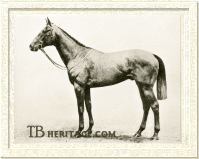
Tetratema
| |
Tetratema retired to stud at Ballylinch, proving more of a dominant influence for speed than his sire. He was the Leading Sire in 1929, when Mr. Jinks won the 2,000 Guineas and Royal Minstrel won the Eclipse Stakes. Tetratema also sired 1,000 Guineas winner Four Course, Irish 2,000 Guineas winner Fourth Hand, Champion Two-Year-Old Foray (II), Champion Two-Year-Old Filly Myrobella, also Tiffin, Theft, Gino, and in America, the filly *Bazaar, champion of her sex at two at three.
|
|
His good sire sons included Royal Minstrel (in America, sire of Singing Wood, First Fiddle, Bransome, etc.), Mr. Jinks (sire of Irish Oaks winner Avoca), Bacteriophage (sire of Teleferique, Biologie), Gino (in America), Theft (in Japan), Foray II (in America), Sherab (sire of Doublerab), Tetratema daughters produced Palestine, Big Game, Mehrali, Montagnana, Vali, Psychic Bid, and Forever Yours. Tetratema died in 1939 and is buried near his sire, The Tetrarch, and son Mr. Jinks at Ballylinch.
|
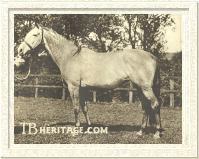
Snow Maiden

Caligula
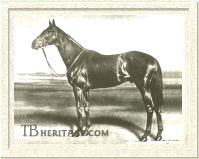
Polemarch
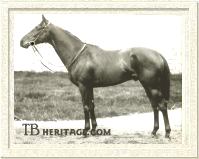
Salmon-Trout
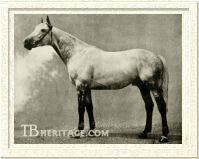
Stefan the Great
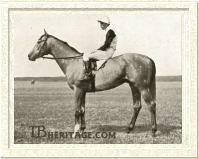
The Satrap

Moti Mahal
| |
A year-younger brother to Irish Oaks winner SNOW MAIDEN (gr.f. 1916), CALIGULA (gr.c. 1917 out of Snoot by Perigord) was from the same crop as Tetratema, but a whole different sort, being a later maturing stayer. Unraced at two, he ran nine times at three, with three victories, in the St. Leger Stakes (Doncaster), Ascot Derby, and a mile race at Newmarket, which he won by ten lengths. He was also third in the St. James's Palace Stakes. Caligula was sent to Germany to stand at stud, but had inherited his sire's infertility, and proved almost sterile. Still, he sired runner and sire Prestissimo, and the mares Balaklava and Messaline.
POLEMARCH (ch. c. 1918 out of Pomace by Polymelus) won the Gimcrack Stakes and Rous Plate at two, and third in the Middle Park Stakes. At three, he won the Doncaster St. Leger, Great Northern Leger, and Knowsley Dinner Stakes. A particularly well-made horse bred along the lines of a true stayer, Polemarch went to stud in Argentina, where he sired the important runners Hechicero and Vino Puro. Polemarch's daughter Sospecha produced the Argentine runner Snob and Saratoga Cup winner Doubtless II.
The Tetrarch's last St. Leger winner was SALMON-TROUT (dk.b. c. 1921 out of Salamandra by St. Frusquin). Purchased as a yearling for 3,000 guineas, he raced for the Aga Khan. His wins at two included the Dewhurst Stakes and at three he won the St. Leger and Princess of Wales's Stakes. A good-looking individual, he sired Irish Oaks winner Salar, Eclipse Stakes and Coronation Cup winner King Salmon (a good sire, and later a leading sire in Brazil), Coronation Cup winner Salmon Leap, and Becti (ancestress of Bagdad and Foolish Pleasure). He was sent to South Africa, as was Salmon Leap.
From the first crop by The Tetrarch, STEFAN THE GREAT (gr.c. 1916 out of Perfect Peach by Persimmon) followed in his sire's footsteps, being undefeated (in only two starts) as a juvenile, winning the Middle Park Stakes and Triennial Produce Stakes. He entered stud in England and sired some useful horses including Kiev, Tolgus, Vespasian, and Fancy Free (dam of Blue Peter), and Portree (dam of Portlaw). Stefan the Great was sent to America in 1923 to stand at Joseph Widener's Elmendorf Stud, where he sired the champion mare Valenciennes, champion steeplechaser Bushranger, and some other good ones like Jean Valjean, Silver Beauty, Silver Cord, and Stephanie (granddam of Count Fleet). He was sent back to Europe after the 1929 season.
Tetratema's younger brother THE SATRAP (gr.c. 1924 out of Scotch Gift by Symington) was the champion two-year-old of his year, winning his first four starts including the Chesham Stakes, July Stakes, Chesterfield Stakes, and Richmond Stakes, but broke down running second in the Rous Memorial Stakes. The Satrap was purchased for about $75,000 and sent to America. Attempts were made to bring him back to racing soundness, but failed, He went to stud at William S. DuPont's Walnut Hall Stud in Virginia where he sired only a few useful runners. His best offspring there was the placed mare Star Fairy (1930), dam of the champion mare Fairy Chant, and the good colt Fairy Manhurst. The Satrap was returned to England in 1938, there siring two of his more important offspring, the grand stayer Auralia (Doncaster Cup, Ascot Gold Vase, Goodwood Stakes) and the mare Staunton (dam of Windy City II).
Bred by the Aga Khan, MOTI MAHAL (gr.f. 1923 out of Maglona by Fugelman) was a small filly, but the Champion Two-Year-Old Filly of 1925. She made nine starts and won five that year including the Ham Produce Stakes (Goodwood), Prince of Wales's Stakes (York), the Two-Year-Old Stakes (Newmarket), Hopeful Stakes (Newmarket), Bretby Post Stakes (Newmarket); she was also second in the Queen Mary Stakes to Aloysia, Champion Breeders' Foal Plate to Bella Minna, and third in the Great Sapling Stakes (Sandown). At three, she won the Coronation Stakes (Ascot, one mile) and was third in the Nunthorpe Stakes (York). As a broodmare, she produced only one winner, but her non-winning daughter, Moti Ranee produced the useful runner and sire His Highness.
Other good runners by The Tetrarch included Sarchedon, Royal Alarm, Tetrameter, Paola (Coronation Stakes, defeating Teresina), Ishtar.
Besides those already noted, other good sire sons of The Tetrarch included Chief Ruler (in New Zealand), Tractor (in New Zealand), Arch-Gift (sire of Irish 2,000 Guineas winner Double Arch), Ethnarch (sire of the sisters Eclair and Infra Red, from which descend Khaled, Mill Reef, and Blushing Groom).
|
Daughters of The Tetrarch were important producers. Besides the most important one of all, Mumtaz Mahal, these included Taj Mahal (dam of 1,000 Guineas winner Taj Mah, also Taj Ud Din and Taj Shirin), Fourfold (dam of Empire Builder and Lindos Ojos), Tetrabbazia (dam of St. Leger winner Singapore and sire Cohort), Tete-a-Tete (dam of Irish Oaks winner Conversation Piece), Firouze Mahal, and Tetranella. In the U.S., The Tetrarch's best producing daughters were La Dauphine (dam of champion two-year-old filly Anita Peabody), Herodias (imported to the U.S. and dam of Pilate and Herodiade, from which descends Cosmic Bomb, Prince John, and Lamb Chop.)
Almost a century later, the world still remembers The Tetrarch for his brilliant speed, and the many unanswered questions left with his early retirement from racing. As a stallion, he left an extensive legacy through too few foals, but if he had only sired Mumtaz Mahal, it would have been enough. Even today, memories of "The Spotted Wonder" and his daughter, "The Flying Filly" can still leave us in awe.
-- Anne Peters |
|
|
|

